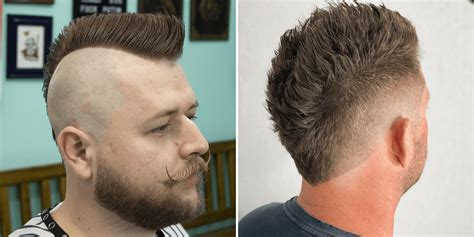Introduction
The world of hairstyling has witnessed a fierce rivalry between two iconic styles: the faux hawk and the mohawk. Both styles exude a bold and edgy aesthetic, but they differ in their execution and suitability. This comprehensive guide will delve into the intricacies of each style, exploring their history, characteristics, benefits, and common mistakes to avoid. By the end of this article, you’ll be equipped to make an informed decision about which style suits your personality and hair type best.

Faux Hawk: The Outwardly Edgy
The faux hawk, a contemporary take on the classic mohawk, has gained immense popularity in recent years. Unlike its traditional counterpart, the faux hawk does not require complete shaving of the sides of the head. Instead, it incorporates shaved or closely cropped temples and nape while preserving length on top. This versatile style allows for a wide range of variations, from subtle to extreme.
Characteristics of a Faux Hawk:
- Preserves length on top of the head
- Gradual or sharp transition from long to short hair on the sides
- May incorporate designs or patterns
- Can be styled with various products and tools
- Offers flexibility and versatility
Mohawk: The Bold and Unapologetic
The mohawk, a timeless style with deep historical roots, represents rebellion and individuality. It involves shaving the sides and back of the head, leaving a strip of longer hair running down the center. The width and height of the mohawk can vary, creating a bold and unmistakable statement.
Characteristics of a Mohawk:
- Sides and back of the head completely shaved
- Long strip of hair running from the front to the back of the head
- May be styled with spikes, braids, or other embellishments
- Symbolizes rebellion, individuality, and nonconformity
- Requires regular maintenance and trimming
Faux Hawk vs Mohawk: Similarities and Differences
| Feature | Faux Hawk | Mohawk |
|---|---|---|
| Length on Top | Preserved | Shaved |
| Sides and Back | Shaved or closely cropped | Completely shaved |
| Maintenance | Moderate | High |
| Versatility | High | Moderate |
| Suitability | Wide range of hair types | Best suited for thick, straight hair |
Benefits and Drawbacks
Faux Hawk:
Benefits:
- Versatile and customizable
- Suits a wide range of face shapes and hair types
- Adds height and volume to fine hair
- Can transition into other hairstyles with ease
Drawbacks:
- Requires regular trimming to maintain length on top
- Can be difficult to style for those with naturally curly hair
Mohawk:
Benefits:
- Bold and attention-grabbing
- Ideal for expressing individuality and rebellion
- Can be customized with various embellishments
- Provides a clean and striking look
Drawbacks:
- Requires constant maintenance and trimming
- Not suitable for all head shapes or hair textures
- Can be perceived as too extreme for some social or professional settings
Common Mistakes to Avoid
Faux Hawk:
- Shaving the sides and back too high, creating an unnatural transition
- Using too much product, resulting in a greasy or weighed-down look
- Attempting to style a faux hawk with curly or thick hair
Mohawk:
- Shaving the strip too narrow, making it appear uneven or incomplete
- Using styling products that weigh down the hair, reducing its volume
- Shaving the sides of the head too close to the scalp, creating irritation or razor burn
Why Faux Hawk vs Mohawk Matters
Choosing a hairstyle that complements your personality and lifestyle is essential. Whether you prefer the subtle edge of a faux hawk or the bold statement of a mohawk, understanding the differences between these styles empowers you to make an informed decision that reflects your true self.
Applications Beyond Hair
The rivalry between faux hawks and mohawks extends beyond the realm of hairstyling. These iconic styles have inspired creative applications in other fields:
- Architecture: The sharp angles and contrast between long and short elements found in faux hawks and mohawks have influenced modern architectural designs.
- Fashion: Designers have incorporated the edgy aesthetic of these hairstyles into clothing, accessories, and footwear collections.
- Product Design: The ergonomic principles behind styling tools for faux hawks and mohawks have led to improvements in hair care products and appliances.
- Art: Artists have used the silhouettes of faux hawks and mohawks as inspiration for paintings, sculptures, and other creative expressions.
FAQs
Q: Which style is easier to maintain?
A: Faux hawks generally require less maintenance than mohawks, as they preserve length on top and do not require constant trimming along the shaved sides.
Q: Is it possible to transition from a faux hawk to a mohawk?
A: Yes, it is possible to transition from a faux hawk to a mohawk by gradually shortening the length on top and shaving the sides closer to the scalp.
Q: Which style is more versatile?
A: Faux hawks offer greater versatility, allowing for various lengths, transitions, and styling options. Mohawks, while striking, tend to be more limited in their variations.
Q: Which style is more suitable for formal occasions?
A: Faux hawks, with their more subtle and adaptable nature, can be dressed up for formal events with appropriate styling and accessories. Mohawks, on the other hand, are typically associated with a more casual or rebellious aesthetic.
Q: How can I customize my faux hawk or mohawk?
A: Faux hawks and mohawks lend themselves to a wide range of customization options, including hair color, patterns, designs, and embellishments. Explore different styling techniques and products to create a unique and personalized look.
Q: What type of hair is best suited for a faux hawk or mohawk?
A: Faux hawks are suitable for most hair types, including fine, thick, curly, or straight hair. Mohawks, however, are best suited for thick, straight hair as they require a clean and defined transition from the shaved sides to the longer strip on top.
